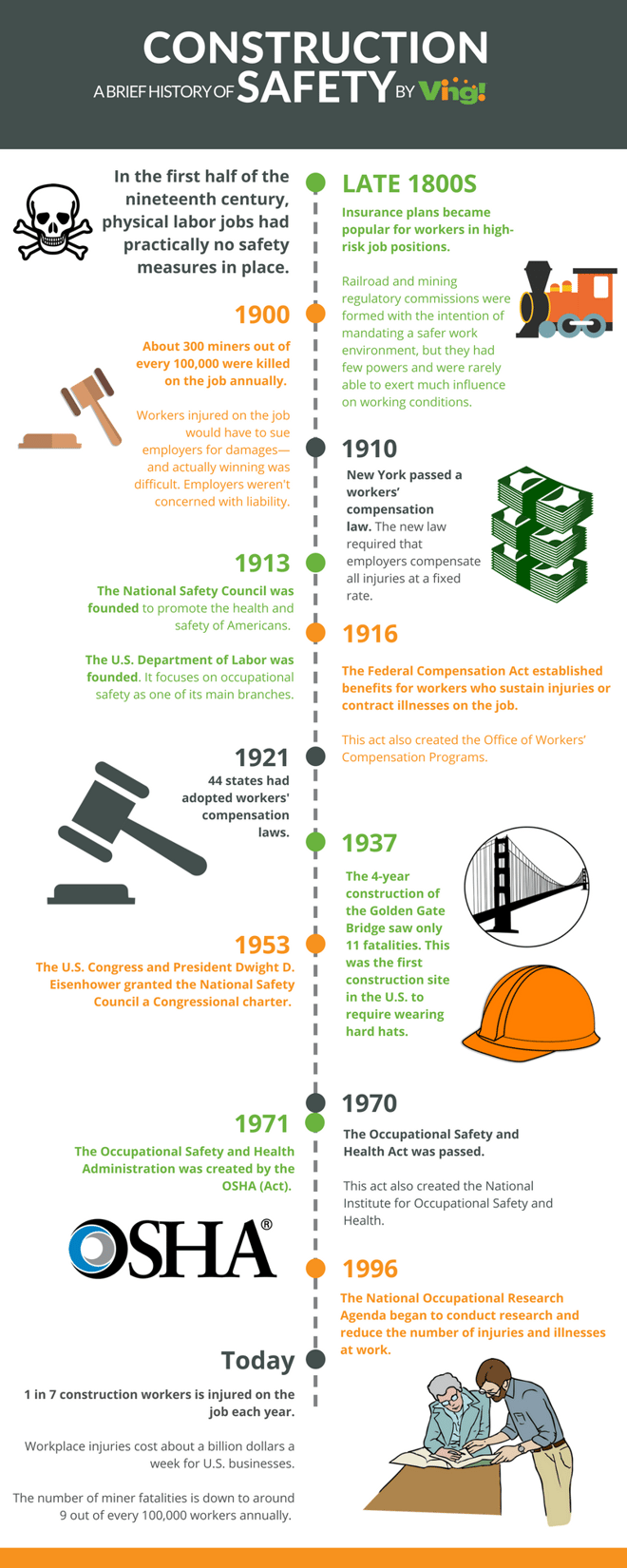In 2016, 10.3 million U.S. workers were employed in the construction industry (source). That means that construction jobs account for about 5% of all of the United States workforce, but construction workers account for more than 17% of workplace fatalities in the American workforce (source).
With so many laws and safety regulations in place, it’s hard to believe how dangerous these jobs still are. By looking at the history of safety in a construction environment, we can see that there’s been a definite improvement in workplace safety; and we can also see that it hasn’t been an easy journey to develop the standards that we have in place today.

Late 1800s
In the first half of the nineteenth century, physical labor jobs had practically no safety measures in place. We’re starting later in the century because this is when things began changing for the better. Post Civil War life, workers began setting aside money and purchasing insurance in case of an accident on the job. Some employers even began providing insurance plans for their employees or providing alternative jobs for their injured men. Some workers left jobs that they felt were too dangerous, and many employers had to raise wages on high-risk jobs to attract enough workers. It was this climate that began to influence changes in industry policies.
Railroad and mining regulatory commissions were formed with the intention of mandating a safer work environment, but they had few powers and were rarely able to exert much influence on working conditions.
1900s
In the year 1900, about three hundred miners out of every one hundred thousand were killed on the job annually (source). To compare, that number is around nine out of every one hundred thousand annually today.
At this point in time, workers injured on the job would have to sue employers for damages—and actually winning was difficult. Only about half of all workplace fatalities resulted in compensation for the family, and even then the amount was only equal to about half a year’s pay. With such a low cost to employers for employee deaths and virtually no legal consequences, safety was of little concern in the workplace.
1910s
Following European examples, New York passed a workers’ compensation law in 1910. Instead of requiring injured workers to sue for damages in court, the new law required that employers compensate all injuries at a fixed rate. For workers, this meant better and more reliable benefits. For employers, this meant more satisfied employees and more predictable costs. By 1921, all except six states had adopted workers’ compensation laws.
The National Safety Council was founded in 1913 to promote the health and safety of Americans. Recognizing the importance of this effort, the U.S. Congress and President Dwight D. Eisenhower granted the NSC a Congressional charter.
The U.S. Department of Labor, which was also founded in 1913, focuses on occupational safety as one of its main branches.
In 1916, the Federal Compensation Act established benefits for workers who sustain injuries or contract illnesses on the job. This act also created the Office of Workers’ Compensation Programs.
1930s
In more than four years of construction, there were only eleven workplace fatalities during the construction of the Golden Gate Bridge. Ten fatalities were caused by a single incident when a suspended platform broke, meaning there were only two fatal incidents during the entire four years of construction. The chief engineer on the project was so concerned with workers’ safety that he spent $130,000 on safety nets and he was responsible for the first construction site in the United States to require wearing hard hats. The safety nets alone saved nineteen lives.
1970s
The Occupational Safety and Health Act was passed in 1970.
An Act to assure safe and healthful working conditions for working men and women; by authorizing enforcement of the standards developed under the Act; by assisting and encouraging the States in their efforts to assure safe and healthful working conditions; by providing for research, information, education, and training in the field of occupational safety and health; and for other purposes.
This act also created the National Institute for Occupational Safety and Health, which conducts research and makes safety recommendations.
The Occupational Safety and Health Administration was created by the OSHA (Act) in 1971, to "assure safe and healthful working conditions for working men and women by setting and enforcing standards and by providing training, outreach, education and assistance." OSHA's workplace safety inspections have been shown to reduce injury rates and injury costs without negative effects to employment, sales, credit ratings, or company survival.
1990s – Today
The National Occupational Research Agenda began in 1996 and works to conduct research and reduce the number of injuries and illnesses at work. It was created by the NIOSH to provide a research framework for many different organizations in collaboration.
Today, one in seven construction workers is injured on the job each year (source).
Workplace injuries cost about a billion dollars a week for U.S. businesses (source).
The importance of construction workers in our society is great. They’re responsible for our roads, houses, businesses, and maintenance of our country’s physical infrastructure. Construction spending in 2016 was estimated at around 1.2 trillion dollars (source). With this job comes many hazards, as we can see from past and present research. We’ve come a long way with safety in a construction environment in the past hundred years or so, but we are still continuing to improve in an effort to eliminate workplace fatalities. Change doesn’t come easy, but we can keep working to bring about change to keep workers safe on the job.
Are you interested in learning more about how Ving can help you improve safety and compliance in your workplace?
Schedule a discovery call with us today, and we'll answer all of your questions.
During our call, we'll discuss:
- Your specific safety and compliance challenges
- How Ving can help you overcome those challenges
- The benefits of using Ving
We'll also answer any questions you have about Ving.
So what are you waiting for? Schedule a discovery call today!






Leave a Comment